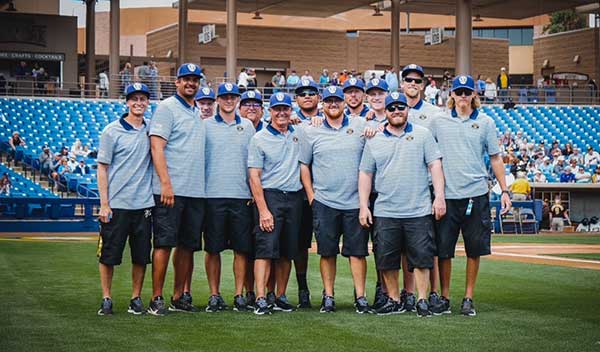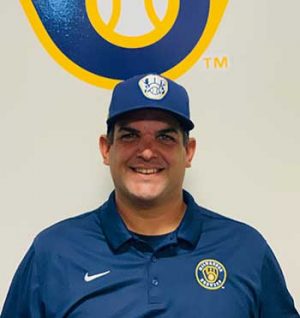For much of the Northern Hemisphere, 2020 has delivered a spring like no other. For Matt Ramirez, director of grounds for the Milwaukee Brewers’ spring training complex here in suburban Phoenix, it has been a period of stark contrasts.
For all of February and some of March, he and his crews watched as ballplayers took to the fields they had renovated for this very purpose, in 2018-19. On March 12, all that stopped. COVID-19 had wiped out the remainder of 2020 spring training, as it has wiped out so many things.
“In one sense, it’s now a kind of groundskeeper’s dream: No one is messing up the fields. They look their best ever!” Ramirez says. “But we also want baseball back in the worst way — for the country’s sake, for the sake of my workers here. We are technically essential workers in Arizona, so we’re maintaining the grass with limited hours. It’s strange. It’s sort of like golf courses being maintained, but with no golfers allowed.”
Ramirez wasn’t joking about the fields looking their very best. All through 2019, he and his team put the finishing touches on a two-phase, $63 million renovation and expansion of the Brewers’ Maryvale complex, known officially as American Family Fields of Phoenix. In other words, these fields really do look better than they ever have: No ballplayer traffic and they’re brand-spanking new.
Today, there are 7.5 fully new or newly renovated baseball fields in Maryvale, along with a new clubhouse. There is a “major league” complex, which includes 2.5 fields and the newly constructed stadium facility — a replica of Miller Park in Milwaukee. All that work was completed, on Ramirez’s watch, in 2018.

The remaining fields constitute the “minor league” complex. All that renovation work was completed in 2019. For a short time, during what seemed a lifetime ago, he watched all the new fields in action, in the intended context. Then it stopped. And it’s not entirely clear when the minor leaguers will return, or the men’s leagues, or the high school games …
In the meantime, he continues to fine-tune a number of his maintenance practices. Several have already paid dividends. Much of this activity has centered around Hydretain, a moisture manager that coats plant roots and soil particles. It actually attracts moisture already present in the soil profile — moisture in the form of water vapor or humidity that would otherwise be lost to evaporation.
“I used it prior to overseeding this past winter,” Ramirez says. “After we overseeded, we noticed faster germination — and we cut one full cycle of irrigation time out of the process. Once we overseed out here, with ryegrass, we traditionally run the irrigation for 10 minutes every three hours — just to germinate the seed. But in the Hydretain-treated areas (I used it on my infields and sideline areas, and common areas where we have native soil), we only needed to water three times a day, every 4.5 hours.
“I don’t honestly know how much water that saved me, but that’s not really why I did it. Quicker germination was my goal,” he says. “It took a week to a week and a half compared to two to three weeks in the past. That made a big difference for us in the early months, like early October/late September. We did the stadium field at that time and the quick turnaround was great, because we do fall men’s leagues events there.”
Ramirez probably wouldn’t have been turned on to Hydretain were it not for Rebecca Knapp, who represents Hydretain and other products from Ecologel (along with tree care products from its sister company, Arborjet). Knapp, like Ramirez, is a sports field lifer. After earning a turfgrass science degree from Penn State, she spent 15 years years on grounds crews with the Philadelphia Phillies, New York Mets and, most recently, the Arizona Diamondbacks. She also served as assistant turf and grounds manager for Major League Soccer’s Houston Dynamo.
“Matt is a total pro. The Brewers are lucky to have him,” Knapp says. “He was with the Chicago Cubs and oversaw the opening of their new spring training facility in Mesa. He has also worked for the Diamondbacks at Chase Field and managed a field in the minor leagues for the Oakland A’s.”
He was hired several years back to oversee the renovations the Brewers were undertaking there in Maryvale.
“Prior to the Brewers taking ownership of the facility, it was looked after by the City of Phoenix. The fields weren’t up to MLB standards but now they are, thanks to the Brewers and Matt Ramirez,” she says. “Today, American Family Fields of Phoenix is truly a state of the art — for games, for training, for rehab assignments.”
Ramirez grew up in Florence, between Phoenix and Tucson, and he’s one of the few Arizonans who is not obliged to choose between the University of Arizona Wildcats and the Arizona State University Sun Devils.

“I did turf classes at both!” he says. “I got my turf degree from Mundus Turf Institute. But for a time, ASU had a golf course turf program. Neither has a turf program any more. But between the U of A horticultural program and the golf program and Mundus, I pieced things together.
“I also did junior college out here, and I played baseball. I knew I wasn’t that great a player, but you know what they say: Getting into this line of work is another way to make the big leagues.”
He started with the Diamondbacks in 2003, as a full-time employee on the crew at Chase Field. But he would eventually work with five different major league systems, bouncing from spring training facilities to big league parks, from franchise to franchise. In 2008, he even went up north, to Kane County, Illinois, to manage a minor league ball park for the Oakland A’s.
“Sometimes that’s how it works. I was assisting in the A’s organization here at Papago Park, and I wanted to venture out,” he says. “So, I went up north — knowing that I would be able to come back eventually. I can’t handle the winters! Jumping back and forth between franchises is not a big deal, pretty common actually. And it worked out great: To be here with the Brewers and to handle the renovation was a great experience.”
Any advice for his peers on handling similarly large-scale renovations?
“Well, get ready for long hours and gray hairs! But honestly, the phased approach worked very well here. It made it manageable.”
With spring training and high school games canceled, Ramirez has continued his winter experimentation into the spring. He continues to find additional ways to deploy Hydretain.
“I’ve been putting it in my infield clay,” he says. “We dry out quickly here in Arizona, and it’s been useful in keeping moisture in the soil longer. I’ve been using it for the sides of the mounds, not the landing areas (where pitchers land on the downside of the mound, after pitch release). We’re always trying to keep moisture out there during games — because it’s so dry and windy here, and spring training games can take forever!”
The technology for Hydretain was developed in an even drier climate, the mining districts of Western Australia. Throughout the 20th century, rural roads to and from these mines had been oiled — to keep the dust down. But Australia outlawed petroleum-based products for this use during the 1970s. Water was a limited option, as those resources were already under considerable strain across this arid region.
Enter environmentally conscious chemist Ronn Hansen, who turned to food-grade hygroscopic humectants, ingredients commonly used to retain moisture in things like toothpaste, gum and cosmetic products. What he discovered was a means by which the dirt roads could be treated to capture evaporating moisture vapor — and bind that moisture to particles on the soil surface. This process kept the dirt roads nominally damp, reducing dusting for an extended period between water cycles.
Starting in the 1990s, Ecologel began adapting this technology to a wider and wider range of turf and horticultural needs — below the surface, in the soil profile. Thanks to Ramirez and Knapp, those include notoriously dry, windy infields across Arizona’s Cactus League.
“I want to see how maybe we can till the Hydretain into the infields here, so it gets down into the base of the clay,” Ramirez says. “When you water it in, it gets moist and stays moist on top. But then, when we drag between innings, we’re turning it over and exposing the drier soil.”
And here again, the notoriously windy conditions in Phoenix make a mess of things.
“I want to maintain moisture through the profile, and I’m pretty sure this is the right stuff for that job,” he says. “My only concern is, it may be tough to get it deep enough into the clay. Tilling may help out there.”
For better or worse, the spring and summer of 2020 should be highly conducive to this sort of fine-tuning and experimentation. Normally, Ramirez would be hosting minor league games by now, plus high school games and camps. The fall is normally dominated by the Arizona Instructional League and the National Amateur Baseball Association World Series.
“All that is up in the air right now,” he says. “It’s hard knowing so little about when things are coming back.”
By: Hal Phillips is a Maine-based freelance writer, managing director of Mandarin Media, Inc.
See the article in Athletic Turf here.
